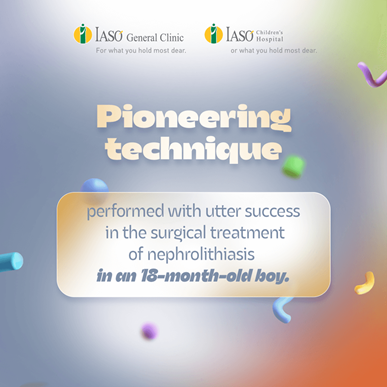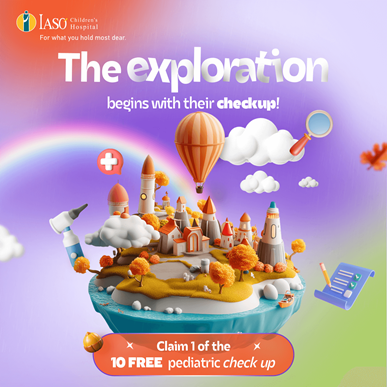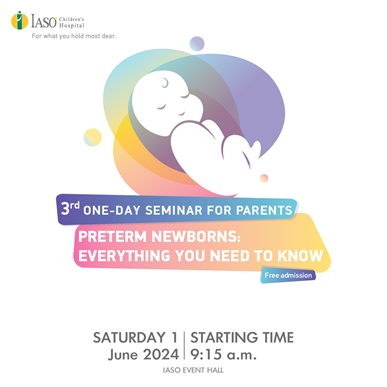
Rheumatology
Pediatric Sector
Pediatric Rheumatology is a Pediatric specialty, the main scope of which is the treatment of autoimmune diseases, which mainly affect the joints, muscles, vessels and other organs. Often, the exact cause of these conditions remains unknown. Over the recent years, a better understanding of pathophysiological mechanisms and the discovery of new drugs have radically changed the course of illnesses and the quality of life of patients, however, without scaling down their severity.
A Pediatric Rheumatologist obtains a detailed history and carries out careful clinical examination of the musculoskeletal system combined with the correct evaluation of the extraskeletal findings. Next, he/she directs further research to confirm the diagnosis, often with the collaboration of our laboratory and our Department of Radiology, which features state-of-the-art equipment.
The Department of Rheumatology at IASO Children’s Hospital treats children suffering from:
- juvenile idiopathic arthritis
- juvenile systemic lupus erythematosus
- juvenile dermatomyositis
- scleroderma
- vasculitides
- autoinflammatory diseases/periodic fever syndromes
- chronic pain syndromes/juvenile fibromyalgia
- other pediatric rheumatic diseases.
Inpatient care is provided for children requiring:
- diagnosis on pediatric rheumatic diseases
- establishment or initiation of a therapeutic regimen and clinical/laboratory monitoring
- newer biological agents that are often administered intravenously
Juvenile Idiopathic Arthritis (JIA) is the most common disease we deal with at our Pediatric Rheumatology department, as it afflicts approximately 1 out of 1,000 children.
Possible symptoms of Juvenile Idiopathic Arthritis include:
- pain, oedema (swelling), skin blushing (redness), and limited range of motion in one or more joints
- joint stiffness, particularly after prolonged immobility
- aching or ailing joint without any injury
Physicians at the Rheumatology Department of IASO Children’s Hospital have a long experience, acquired in major healthcare institutions abroad, of using the latest treatment methods that have significantly improved our patients’ quality of life in recent years.
In particular, regarding the treatment of young JIA patients, intraarticular corticosteroid injections enable us to treat even the smallest joints. Injections are ultrasound-guided, which allows for greater accuracy and better overall treatment outcome. After the injection procedure, the patient can go home within a matter of hours.
Systemic Lupus Erythematosus (SLE) is a rare condition affecting 1 out of 10,000 children. Common age of onset for children is >12 years, i.e. it usually occurs in adolescence. It afflicts girls more often, by a ratio of 4.5 : 1 (9-10 : 1 for adult women). SLE is a multi-system disorder that affects several organs, like skin, joints, kidneys, blood cells, or even the central nervous system. However, the symptom most commonly described by patients is fatigue, which is why we often test adolescents for SLE when they report tiredness. The same criteria apply for juvenile and adult SLE diagnosis. There is an established correlation between antinuclear antibodies (ANA) and SLE, but such antibodies can also be present in several autoimmune diseases, as well as in 15% of the general population (at a relatively low count) without any underlying condition.
Juvenile Dermatomyositis (JDM) is a rare condition, with 2-4 out of 1,000,000 children diagnosed every year. It can manifest at any age, but most frequently around the age of 5-10. It is slightly more common among girls compared with boys (2.7 :1). It affects both skin and muscles, and its diagnosis is based on identifying the typical rash and symmetrical muscle weakness in the thighs and shoulders. Dermatomyositis often occurs in combination with arthritis.
Scleroderma is a rare disease which causes skin inflammation followed by fibrosis (scar tissue), or sclerosis. It is divided into two types: Localized Scleroderma (Morphea), which only affects the skin, and Systemic Scleroderma, which also afflicts internal organs, like the lungs, kidneys, or gastrointestinal system, while it quite often occurs in combination with Raynaud’s phenomenon. Localized Scleroderma is rather more common than Systemic Scleroderma, which arises at an approximate rate of much less than 1 out of 1,000,000 children per year.
Vasculitis is an umbrella term for a group of rare diseases that share the symptom of blood vessel inflammation, most commonly of arteries and less often of veins. The frequency of vasculitis in children is unknown, but it is estimated that it represents 1-6% of pediatric rheumatology conditions. There are several types of vasculitis which greatly vary in terms of symptoms, gravity and duration. Vasculitis affects both men and women, and all age groups. Among children, the most common type of vasculitis is Henoch-Schönlein purpura (HSP) and Kawasaki disease (KD), which are normally diagnosed and treated by pediatricians. Other types of vasculitis, such as Polyarteritis Nodosa (PAN), Takayasu’s arteritis, Wegener granulomatosis, and Microscopic Polyangiitis (MPA), are much less common yet more severe diseases, which attack the body on multiple fronts, affecting the kidneys, skin, respiratory system etc.
Autoinflammatory Diseases/Periodic Fever Syndromes were only recently discovered. Their pathophysiology differs from that of autoimmune diseases in that a different part of the immune system is affected, mainly as regards the inflammation mechanism. The most typical symptom is fever, which is unaccounted for, but it also entails other symptoms like rash, abdominal pain, joint pain etc. Symptoms are relapsing and recurrent. Very often the diagnosis is confirmed by genetic testing. Among the better-known period fever syndromes feature PFAPA, Familial Mediterranean Fever (FMF), TRAPS, Hyper-IgD syndrome, and CAPS. Other relevant syndromes are much rarer, but, as genetics advances, we are always discovering new ones.
Chronic pain syndromes or juvenile fibromyalgia are terms used to describe chronic diffuse myoskeletal pain of unknown origin often faced by many children. They affect 2% - 6% of children/adolescents and are more common among girls than boys by a ratio of 4:1. They are often triggered by an injury or other incident. The most common symptoms reported are: diffuse myoskeletal paint (>90%), headaches, dizziness (>70%), sleep disorders (70%), and fatigue. They often occur in combination with other diagnoses, like irritable bowel syndrome, orthostatic tachycardia, depression, or stress disorders. Diagnosis is achieved by eliminating underlying conditions with similar symptoms.









